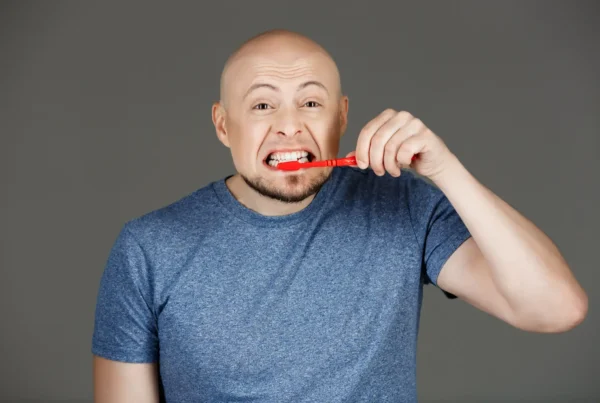- What is a diastema?
- Is a diastema just an aesthetic issue?
- Types and causes of diastema
- Orthodontic treatment for diastema
- Veneers as a treatment for diastema
- Bonding as a treatment for diastema using composite material
- Is frenulum surgery necessary in people with a gap between their front teeth?
- Should you be ashamed of your diastema? It could be your unique charm
- Does a diastema in children require treatment?
- Can a diastema be inherited?
- What does diastema treatment look like?

Aesthetic defect that can negatively affect self-confidence and social interactions. But what exactly is a diastema? What are its causes and types? And why shouldn’t you be ashamed of having one? You’ll find all the answers in this article.
What is a diastema?
A diastema is the gap between the central upper incisors, also known as the upper front teeth. While it’s common in animals like beavers, monkeys, ruminants, or rodents, it’s not considered a natural occurrence in humans.
Is a diastema just an aesthetic issue?
That depends on the size of the gap. A small diastema, up to 2 mm wide, is classified as a cosmetic issue. When the gap exceeds 2 mm, it is considered a malocclusion that may require orthodontic treatment.
Types and causes of diastema
There are three main types of diastema. A true diastema is caused by an overgrown labial frenulum, the vertical fold connecting the upper lip to the gums. A pseudo-diastema occurs when the lateral incisors are smaller than average or completely missing. It may also be caused by the presence of a supernumerary tooth that puts pressure on the central incisors or by hypodontia, the congenital absence of one or more teeth. The third type is a physiological diastema, which appears temporarily in children between the ages of 7 and 9 and usually resolves on its own.
Diastemas can also be classified based on the position of the central incisors. A converging diastema occurs when the roots are spaced apart, and the crowns tilt inward. A diverging diastema is when the crowns are spaced outward while the roots are close together. A parallel diastema appears when the incisors are evenly spaced and parallel to each other.
READ MORE: CROSSBITE
Orthodontic treatment for diastema
There are several ways to close a gap between teeth, and the choice of treatment depends on the underlying cause. Orthodontic treatment with fixed, removable, or clear aligners is one of the most common methods. Converging diastemas can only be corrected with a fixed appliance. Diverging diastemas are usually treated with removable braces. If the gap is caused by a missing lateral incisor, a dental implant may be necessary. In the case of a supernumerary tooth, extraction is required.
Veneers as a treatment for diastema
If the gap is small and purely cosmetic, veneers or dental bonding can help close it. This is a quick and effective method to enhance the smile. Porcelain veneers provide the best results as they closely resemble natural teeth, even though they are more expensive. Before veneers can be placed, the tooth surface must be properly prepared.
Bonding as a treatment for diastema using composite material
Bonding involves applying composite resin to both central incisors to fill the gap. It is the quickest and most affordable option, but it is also less durable than veneers. Composite can chip or discolor over time.
Is frenulum surgery necessary in people with a gap between their front teeth?
In children with an overgrown or incorrectly attached upper labial frenulum and a diastema in their baby teeth, the issue may resolve on its own as they grow. The frenulum can move higher naturally, which may close the gap. Surgery is only considered after permanent canines erupt, around age 11, and if the gap persists. If pulling the upper lip upward causes the gum between the central incisors to turn pale (a sign of tension), surgical correction may be necessary.
Should you be ashamed of your diastema? It could be your unique charm
Absolutely not. Having a diastema is not your fault. Some people feel embarrassed by it and avoid social situations or smiling confidently. But many others embrace it. Several famous individuals have turned their diastema into a signature feature, including actors and musicians like Eddie Murphy, Elijah Wood, Tomasz Karolak, Olaf Lubaszenko, and Elton John. In fact, some people consider it an attractive trait that helps them stand out. In France, a diastema is even seen as a symbol of good luck.
Does a diastema in children require treatment?
In most cases, a diastema in children doesn’t require treatment. It often results from missing lateral teeth that haven’t erupted yet. As children grow, their jaws also expand, which can naturally close the gap. Still, it’s worth consulting a pediatric dentist. If the cause isn’t part of normal development, appropriate treatment should be considered. Therapy can begin once all permanent teeth have erupted.
Can a diastema be inherited?
Yes, a diastema can be hereditary, especially if caused by an overgrown labial frenulum. It can also be passed down genetically due to the proportion between tooth size and jawbone width, which affects tooth alignment.
What does diastema treatment look like?
If you have a diastema, it’s best to consult an orthodontist. A professional can determine whether it requires treatment or if it’s simply a minor aesthetic feature with no impact on your overall dental health.





